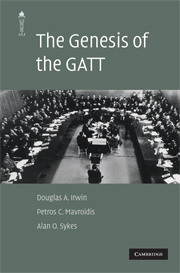Annex B: Negotiating Committees and Subcommittees
Published online by Cambridge University Press: 12 April 2011
Summary
London Conference
The Preparatory Committee established the following working committees:
(f) Committee I: Employment and Economic Activity;
(g) Committee II: General Commercial Policy;
(h) Committee III: Restrictive Business Practices;
(i) Committee IV: Intergovernmental Commodity Arrangements;
(j) Committee V: Administration and Organization;
A sixth committee, the Joint Committee on Industrial Development, was established following a joint meeting of Committees I and II. During the First Session, Mr. Suetens (Belgium) was elected as Chairman of the Preparatory Committee, with Mr. Augenthaler (Czechoslovakia) as first, and Mr. Alvarez (Cuba) as second vice-chairman. The Chairman of Committee II was Coombs (Australia), with Speekenbrink (Netherlands) acting as vice-chairman. Committee II established a series of Sub-committees that were requested to report their findings to the main Committee (II): the single most important of all Sub-committees established is the Technical Sub-committee, which dealt with the following issues:
a. national treatment on internal taxation and regulation;
b. freedom of transit;
c. antidumping and countervailing duties;
d. tariff valuation;
e. customs formalities;
f. marks of origin;
g. publication and administration of trade regulations – advance notice to restrictive regulations information, statistics, and trade terminology;
h. boycotts;
i. general exceptions.
Participation to the Technical Sub-committee was open to delegates for all the countries represented on the Preparatory Committee. Mr. Videla (Chile) acted as Chairman, and delegates of six different nationalities acted as rapporteurs. The choice of six rapporteurs was justified by the wish to accelerate the process. The six rapporteurs were chosen from the Belgian (Luxembourg), Canadian, French, Dutch, UK, and U.S. delegations. The U.S. rapporteur was Mr.
- Type
- Chapter
- Information
- The Genesis of the GATT , pp. 285 - 296Publisher: Cambridge University PressPrint publication year: 2008

